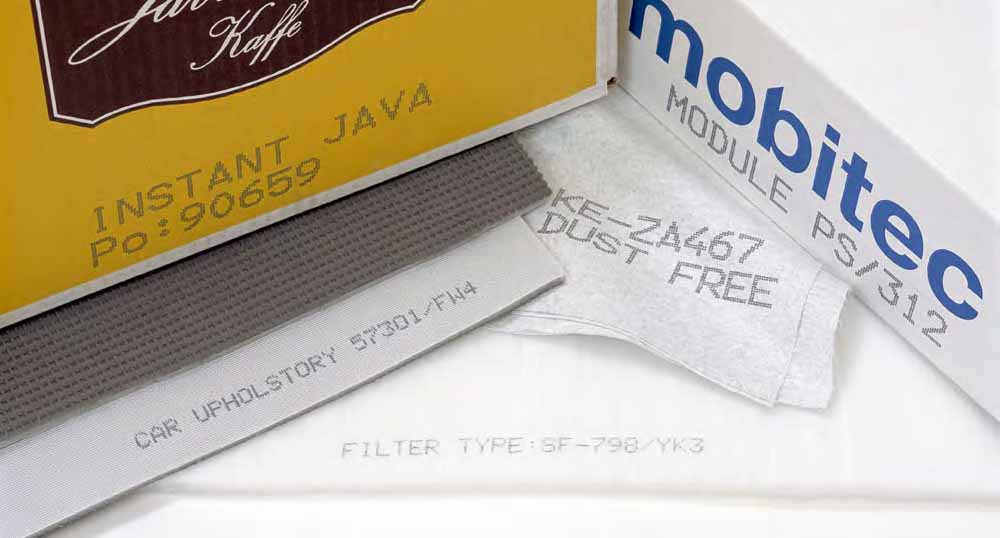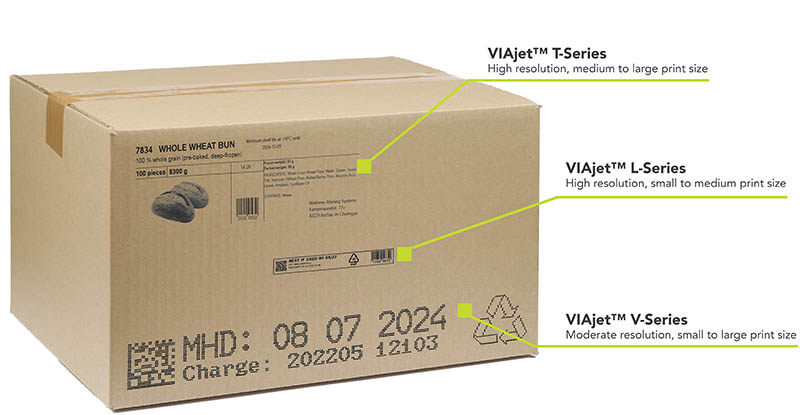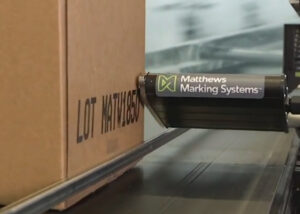Factors to Consider When Selecting a Marking System

A variety of factors need to be considered when deciding on a marking system for your packaging. Image courtesy of Matthews Marking.
How to Find the Right Solution For Your Production Requirements
By Kevin Havre, Global Product Manager at Matthews Marking Systems
A variety of factors need to be considered when deciding on a marking system for your packaging. For starters, you’ll need to know if the marking system can meet your production requirements for the following:
- Your line speeds
- The distance to the packages from the conveyor or production line (i.e. throw distance)
- The substrate of your packages (porous or non-porous)
- What type of mark you need to make (alphanumeric text, barcode, 2D code, etc.)
- Your environment (temperature, humidity, dusty, etc.)
- Desired automation and connection with business data systems
- Operator ease of use/ease of maintenance
- Reliability / uptime

TIJ and piezoelectric marking systems typically deliver higher resolution relative to valve-jet marking, which is important if you’re printing barcodes or similar codes or markings. Image courtesy of Matthews Marking Systems.
What are valve-based inkjet printers?
Valve-based inkjet printers (also known as valve-jet) are a proven marking technology for virtually any substrate used in almost any environment. Unlike thermal inkjet and piezo inkjet printing, valve-jet printers use a series of valve-controlled jets to pressurize ink and then fire individual drops on your substrate. This enables valve-jet printers to have a greater throw distance to the substrate. Additionally, these systems are incredibly robust and can withstand harsh, challenging environments that challenge other types of inkjet printing/marking.
How does the technology differ between drop-on-demand valve inkjet printers versus other options?

Valve-based inkjet printers (also known as valve-jet) are a proven marking technology for virtually any substrate used in almost any environment. Image courtesy of Matthews Marking Systems.
Drop-on-demand valve inkjet printers are ideal for simple, bold alphanumeric characters where speed and reliability are paramount. Two other popular technologies used for printing/marking are thermal inkjet (TIJ) and piezoelectric inkjet. TIJ uses heat to pressurize ink in a cartridge which causes a bubble to form. The pressure from the bubble causes the ink to fire from the cartridge (printhead) and onto your substrate.
Piezoelectric inkjet printers use electrical charges and vibrations to send droplets of ink onto a substrate. The electrical charge excites a crystal or ceramic element in the printhead which oscillates ink into droplets before they’re fired through a nozzle.
TIJ and piezoelectric marking systems are good if your packages will run close to the printhead on the conveyor, that is a short throw distance. Both typically deliver higher resolution relative to valve-jet marking, which is important if you’re printing barcodes or similar codes or markings.
However, valve-jet printing is ideal if your packages aren’t in the ideal throw range of either and you’re not concerned with high resolution barcodes and the like. If you need a highly reliable, robust marking system that delivers a lower cost per mark than other technologies, then valve-jet is a perfect solution.
About the Author
Kevin Havre has over 25 years’ experience managing printing and mobile computing products, for global commercial (B2B) markets. Based in Matthews’ Wilsonville, Oregon office, Kevin is a global product manager for Matthews Marking Systems where he is focused on aligning products with customer needs and driving business strategies for key products and industries. In the winter months, you’ll often find him rescuing stranded or injured skiers from the slopes of Oregon’s Mt. Hood where he volunteers as member of the local ski patrol.






